Over the last 20 years, we have created a garden, inspired by the site. We are now bound to the site in ways we would never have thought possible.
Where we began
Our garden of about one hectare is part of a 21 ha property bought in 1997. It was denuded farmland above Port Elliot in South Australia. Our aim was afforestation for biodiversity and native fauna.
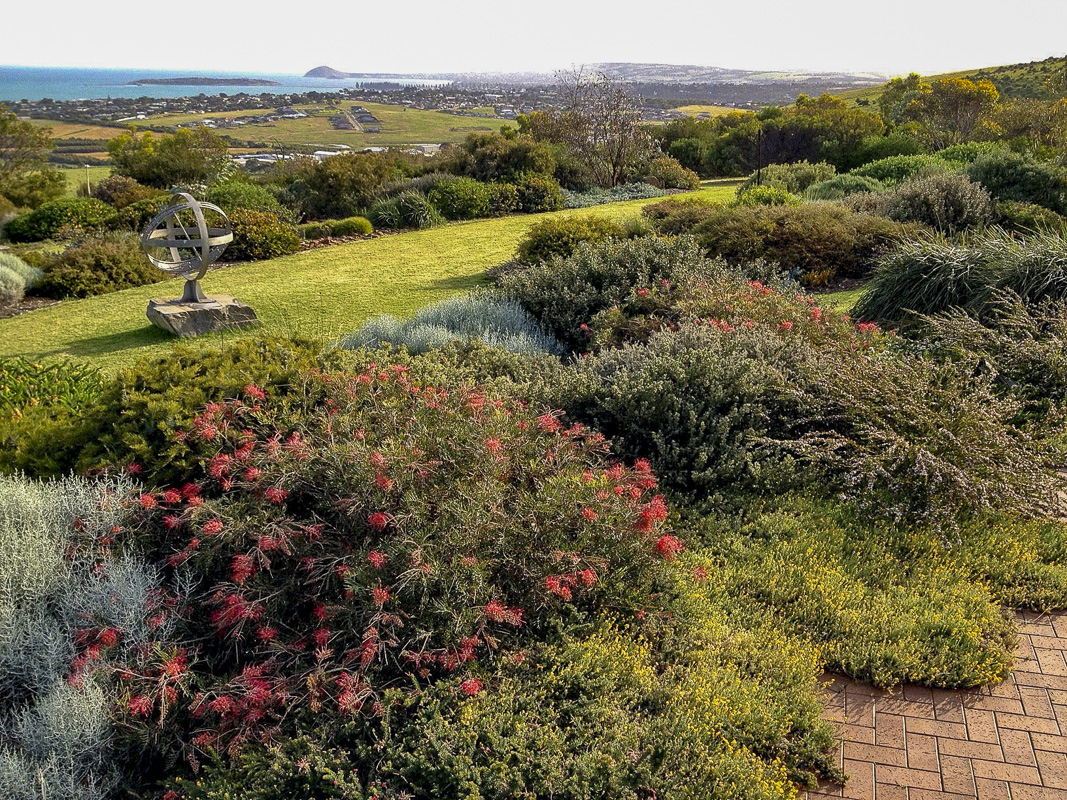
Sea views a borrowed landscape
Advantages
- Magnificent sea views from north of Victor Harbor around to the Murray Mouth and Goolwa Lakes to the south and east
- Hills views to the west and north.
- The land itself contains a hill, two gullies and a large plateau in the middle. This is now where the house and garden are now established.
Disadvantages
- Some very steep sections
- Large areas of old olives to be removed along with many other woody weeds
- No mains water
- Strong winds and
- Much bluestone rock.
On the whole 21 ha, there was one eucalypt, one Olearia, three casuarinas and a few acacias with hardly a herb or native grass to be seen.
First steps to clear the site
Immediately we set about clearing and then planting the wider property, starting with a windbreak around a proposed house site. When we began we were aware of a few birds of prey, a few kangaroos and the odd snake. But there was virtually no habitat for smaller birds apart from the olives and woody weeds.
As I write this, a kangaroo is drinking from a birdbath by the lawn. There are also are up to two dozen Western Greys frequenting the property now. Vast numbers of birds of many species now live here. These include the New Holland and other honeyeaters, wrens, finches, thornbills, golden whistlers and grey shrike thrushes and pardalotes. Parrots and magpies are also in residence, of course. We don’t know how many echidnas, but enough to dig up my stone paths!
Our design intent
The garden was designed to blend in with this revegetation. Over time it would contain a gradually higher proportion of local species the further one moved from the house. This included acacias such as A. calamifolia, Bursaria spinosa and various Melaleuca. We chose a contour running between our two sheds as the garden’s southern boundary. This was a curved ‘Tank Track’ of about 180m. The water tanks, now five in all capable of storing some 160,000 litres, were cut into the hill near the second shed.
Moving in
In 2001 we moved into our new L-shaped house. It was carefully designed to maximise views from all sides as the southern coastline swings around. I was so keen to start the garden that building sand, rubble, and rocks flung up from the ripping of garden beds were not removed.
Warning and advice to new garden developers: spend time preparing the soil first!
The soil here is heavy loam over clay with a pH of 6, with some areas predominantly clay. I have spent the last 20 years digging up rock as I replace or extend planting. At the same time I have been gradually adding around 20 tonnes of gypsum.
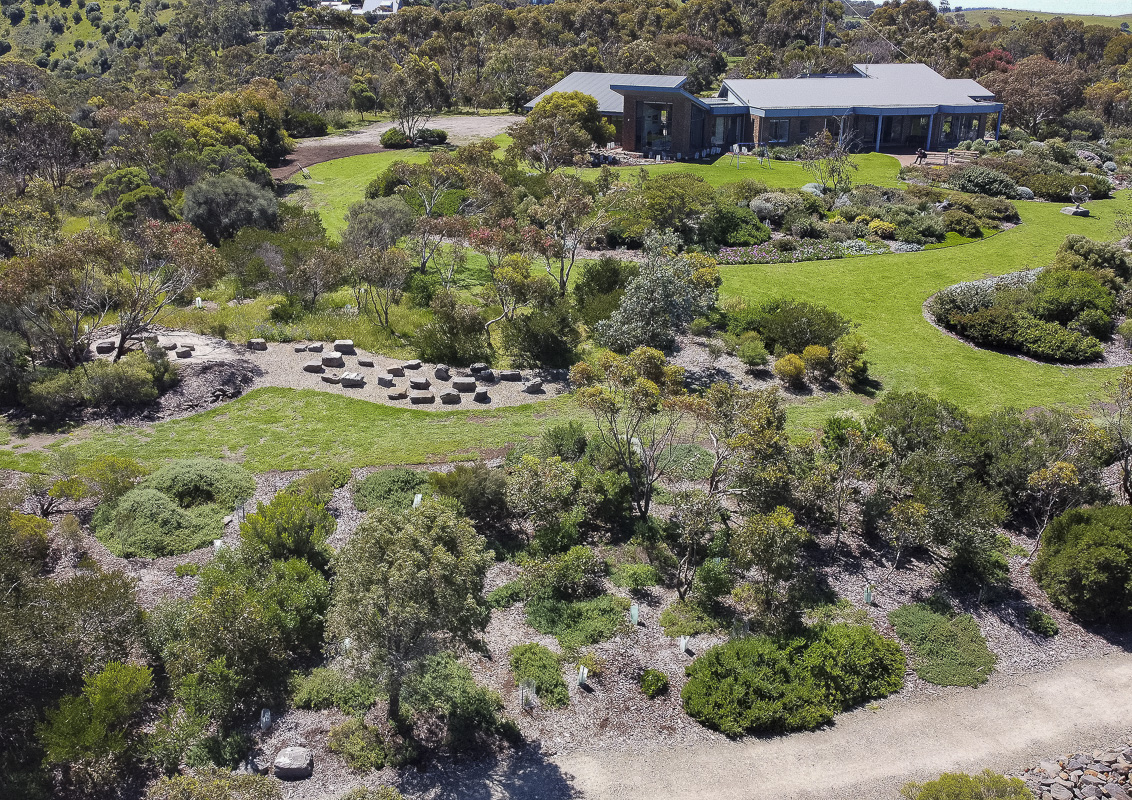
Garden design in earnest inspired by the site
And so the garden began. A plan was drawn up by Alan Fisher of Gardens Australis, based on circles, semi-circles and curving beds surrounded by cut grass. Planting was to be kept low to preserve the views of the sea. In addition, most areas were mulched (28 x 13 cubic metre truckloads of it). To the south (seaside) of the house, there are island beds in lawn. On the east side, the garden was divided by one gravel and several stone paths. To the north, a brick patio, ephemeral pond, and several semi-circular garden beds were planned.
By December 2002 all the garden beds contained at least some tube stock.
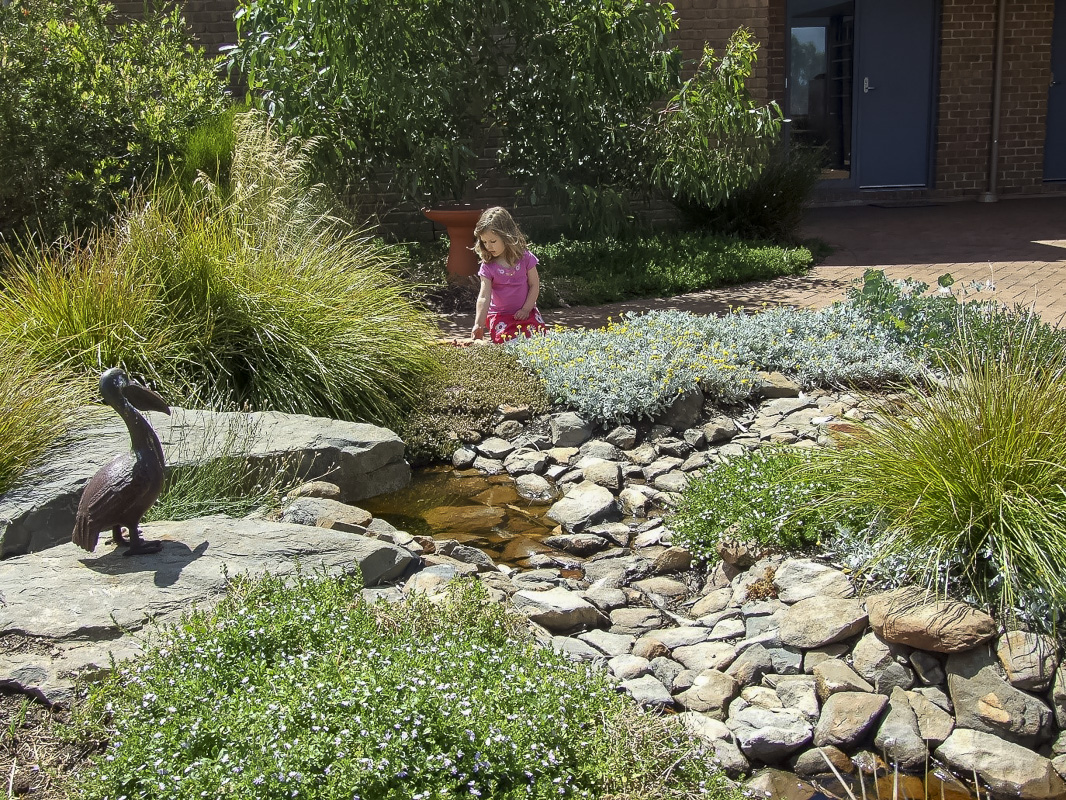
Ephemeral pond north of the kitchen
North of the patio, an entry roundabout with parking for 4 cars was ripped, mulched and planted with Eucalyptus scoparia. We added a grass understorey of Poa poiformis with shrubs of Leucophyta brownii defining the path to the house.
Since then, as most of the E. scoparias failed, some Casuarina verticillata have been added, and Eucalyptus citriodora. The delicate perfume of the lemon-scented gum leaves wafts near the house in both hot and rainy weather.

Roundabout with Poa foiformis, Leucophyta brownii and Eucalyptus scoparia
Successes and challenges as the years went on
In the next few years, we planted another large bed at the northern end of the long north lawn. It was called the Rock Garden for obvious reasons. It was then planted mostly with bigger shrubs – Melaleuca, Hakea, Acacia and a stand of Eucalyptus caesia.
Overall, while some plants grew well, there were disappointments in the early years. The official average rainfall of 480 mm did not eventuate. We have seen the average gradually falling over 20 years, with some significant drought periods. I now tend to look for plants requiring a minimum rainfall of 350 mm or less.
Winds were extreme from the beginning, and while at first there were no rabbits, they soon found us. Everything we plant must be guarded, at least initially. Even hares like living here – hence damaged bark on trunks of trees and shrubs.
Unfortunately, much of the initial planting was not suitable for our soil and for full sun in increasingly hot summers. Correa reflexa, Scaevola sp., Kennedia prostrata, Dampiera sp., Grevillea lanigera (Mt Tamboritha form) and a grey form pf Chrysocephalum apiculatum were favourites that needed to be replaced. I have now minimised the number of Anigozanthos for similar reasons.
Hindsight is a wonderful thing
In hindsight, early planting around the house was too low to balance the size of the building. I had used Myoporum parvifolium and Goodenia ovata (pros.), for example. Although these groundcovers grew quickly in the first, wet years, they looked like giant green cowpats and needed variation.
Looking back, I think small, sparsely leaved trees would have fulfilled this need. Unfortunately I impetuously removed most of them. I hadnt realised how hard it would be to achieve that rate of growth in the future. Perhaps this was a function of the fertilising effect of residual cow manure as well as wet seasons.
Beyond this low foreground, the original plan was for gently graded shrub heights across the beds. Low shrubs would rise gradually in height across a bed, east to west. However, we found that in the first few years the frequent gale-force winds, south-west in winter and north-west in summer, pruned everything to the same height. In fact, brittle bushes such as some Correa were often halved to a semi-circular shape, and I almost despaired.
Plants gradually knitted together
Gradually plants edged upwards and outwards until they knitted together to gain mutual protection. Hardy Grevilleas such as ‘Lemon Supreme’ and ‘Flora Mason’, low Thelemanniana, even ‘Coconut Ice’ and ‘Billy Bonkers’ established a framework. Calothamnus quadrifidus (pros.), Alyogyne and Eremophila glabra, Hakea ‘Burrendong Beauty’ and a few hardy Correa filled in the garden. Add a few more years and the daring, most hardy bushes put their heads up above their surroundings. As a result, we started to enjoy some variety in the profile of the garden plus its increasing density. Seeds of Acacia pycnantha were welcome to grow where they wanted. Short-lived though they be, their dead branches now provide sculptural perches for birds. That variation in height evidently inhibits the torpedo flight of the more aggressive birds giving small, shy birds a chance to make use of the cover.
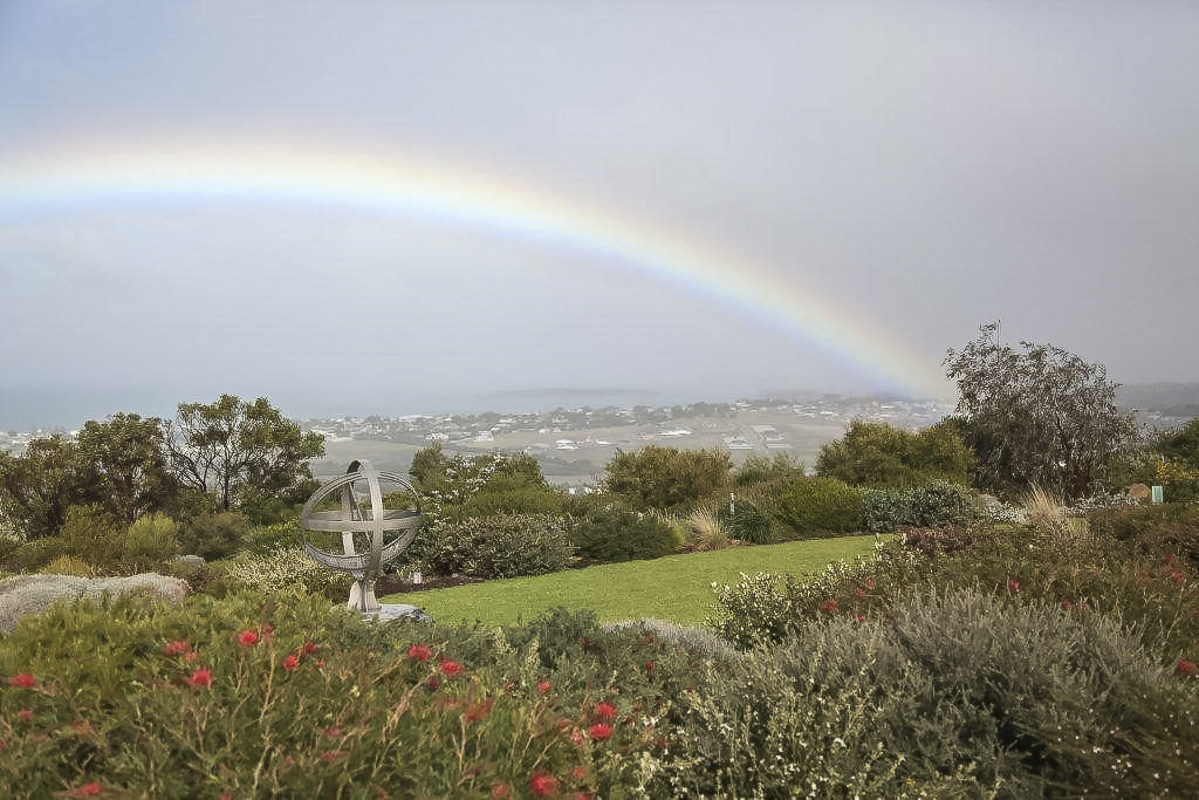
Garden south of house, with sun dial
Our thinking has evolved inspired by the site
Our attitude to height of vegetation overall has also changed. At first we were insistent that nothing impede our views of the sea. However, over time we have come to appreciate glimpses rather than straight panoramas of water. Sparse, more open trees such as Eucalyptus caesia are ideal, and provide vantage points for birds large and small. It’s unfortunate that the wind and comparative dryness have killed most of the E. caesia I have tried over the years. Instead Eucalyptus pulverulenta, normally requiring more water, is doing well on the south side of the house. It’s also going well in some beds where I can water more readily. In other places dense foliage provided by Acacia iteaphylla and heavy-canopied eucalypts such as E. torquata (the lovely WA coral tree) obscure housing developments below us, and provide shade.
In particularly difficult places, I am trying drought-tolerant mallees such as Eucalyptus websteriana, E. youngiana, E. calycogona, E. pimpiniana and slender E. rosacea along with Senna artemisioides. While retaining the overall effect of rolling, rounded shrubs, the garden has benefited from more height and variety. Several Eucalyptus kruseana, growing even smaller here than normal, have beautiful rounded silver-grey leaves and tightly packed lemon flowers. They add contrast and provide florist materials.
When plants fail, I replace with proven successes
In general, when plants fail I try to replace them with proven successes. Melaleuca coccinea is one such. It grows reliably, with no extra water, and produces brilliant pink/red flowers at times of the year. It does give the garden a lift. Nothing beats Hakea ‘Burrendong Beauty’ in autumn. As a result, bushes are now dotted throughout the garden. Some are suffering from old age but sometimes responding well to a stiff prune.
Plants for larger areas
For bigger areas, Melaleuca lanceolata, M. nesophila, and M. diosmifolia, also Acacia argyrophylla, are among the most hardy. Recently I have discovered Eremophila mackinlayi. This is fast-growing and vigorous, with soft grey-green leaves and strong purple flowers in summer and autumn. There are, of course, more: I must add Eremophila calorhabdos, not because it’s totally reliable, but because it is very beautiful, and worth several tries. Its branches bend almost to the ground under the weight of a New Holland honeyeater.
Smaller plants
Amongst the smaller plants, early and continuing successes include Leucophyta brownii. From sandy coastal regions it always leaps ahead and can be trusted to liven a dark spot in no time at all; Dianella brevicaulis, native to this site, pops up everywhere, often in the middle of other plants where it’s not wanted, but I admire its stamina. The stand-out success for constant colour is Xerochrysum bracteatum, fast-growing and lasting at least a couple of seasons if spent flowers are lopped regularly. It is easily propagated from cuttings, a delight in the garden and perfect in arrangements.
Kunzea pomifera, also from the sandhills, has spread slowly but surely, forming a dense groundcover with the advantage of beautiful fluffy flowers and sweet, edible fruits, mostly snaffled by the kangaroos. Misty green, fine-leaved Chrysocephalum ramosissimum flourishes, particularly amongst the paving bricks, with only a little summer water, and Banksia petiolaris spreads widely, with its unusual serrated leaves and striking ground-hugging flower cones.
Managing weeds on the site
Dense groundcover along with thick mulch has been paramount in controlling the myriad pasture grass and weed seeds that blow in from the ungardened parts of the property. Over large areas near the house, West Australian Eremophila biserrata has established strongly. It provides a bright contrast to darker shrubs.
Several Acacia baileyana (prostrate form), dense, silver-grey and cascading with golden flowers in spring, have grown to an immense width and keep weeds at bay, along with shrubs such as the prickly Hakea lissocarpha, and Correa ‘Dusky Bells’.
Rhagodia spinescens surprised us with its big mounds, and invited formal trimming which we hadn’t intended, but the contrast enhances the more asymmetric, natural forms of other shrubs. Every couple of years as mulch breaks down, some needs replacing. We can now create our own from dead branches and trees on the property.
Paths of grass meander through the gardens
Naively we first thought that instead of lawn meandering around and between garden beds we would simply mow the pasture grass. Unfortunately, vast areas of waving seed heads, however often we mowed, soon proved impossible. This ‘void’ space was much too large to water, or to establish with Microlaena stipoides, so kikuyu was chosen. We planted it ourselves over several years, slicing up pallets of lawn into small rectangles or plugs and digging them in. On the whole, this was very successful. The grass covers the area well, turning cornflake-brown in summer but greening up with autumn/winter rain.
Drought years have taken a toll on the garden design
The two drought years of 2017-18 and limited rainfall since have taken a heavy toll, however, and large areas have died completely, partly due to the surrounding trees now taking up more water. While we can reduce the grassed area by widening the mulching around clusters of trees in the lawn, we will still need to top-dress and replant quite an expanse in the next couple of years – a daunting prospect as we have a new Border collie pup that particularly likes digging!
Recently the western windbreak near the house has been extended to enclose part of the lawned area, and one more large semi-circular garden bed has been added to complement a western extension to the house built some years ago. The focal point for this is an established, spreading Eucalyptus leucoxylon megalocarpa. Strips of butyl rubber left over from the ephemeral pond outside the kitchen, to the north of the house, were used to line a rock-filled ‘creek bed’. The low planting here is just starting to become established and will create immediate interest from the windows.
Feature rocks from the site abound
Rock from the property has been at times a great frustration but also a great delight, with its varied colour and texture. Feature rocks were placed in the garden initially, and while waiting for the original garden to be laid out I managed to make some stone paths between beds and a sneak path of stepping stones.
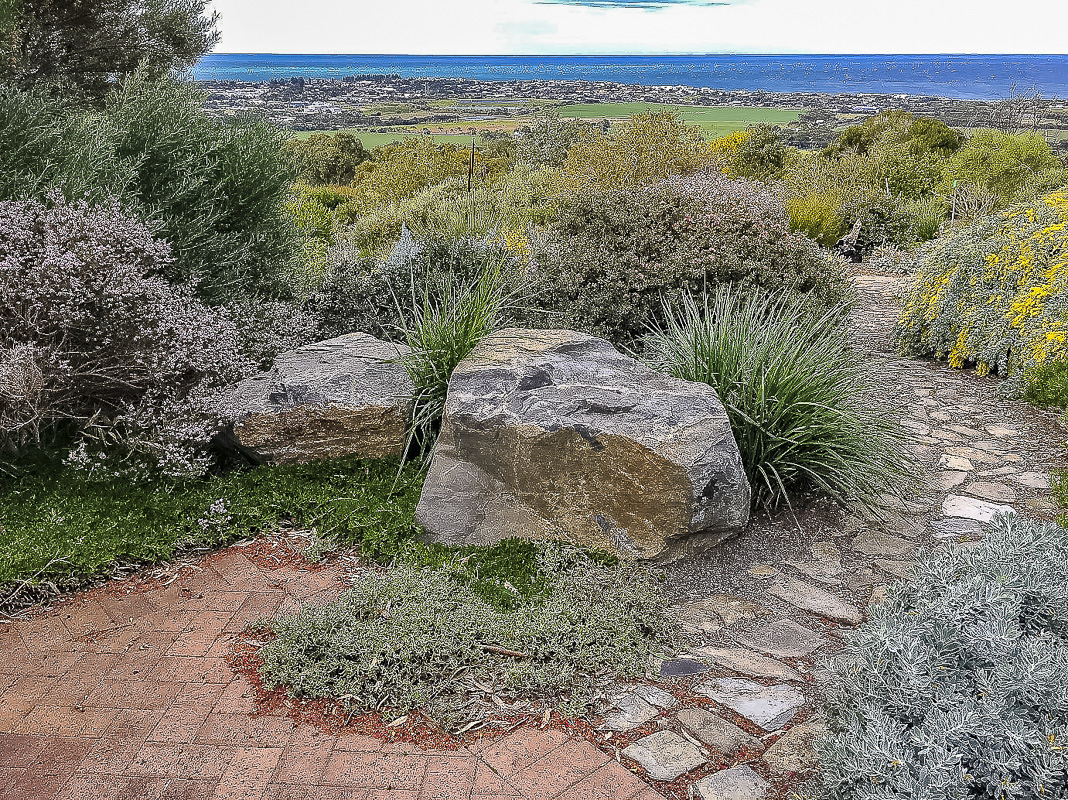
Large rocks and stone path, with Acacia baileyana (pros.) top R
One wall of the house is our own stone. This is carried through in a low retaining wall to the west of the house, and recently in two undulating walls leading to the feature sun dial, itself mounted on a massive rock. Inscription: ‘Today is yesterday’s tomorrow’, always a timely reminder for garden jobs. This is part of garden design inspired by the site.
At first when we dug up stones we used them as fill to extend an apron in front of one of the sheds, but then recognised their beauty and usefulness. In the occasional patches of garden where there are rock seams which prevent planting we have laid stones as dry creek beds. In the roundabout, between the grasses, we have spread them as rock mulch to add interest. To keep rabbits from young plants, I have built low, circular drystone walls as a sort of sculptural addition. All sizes of rock and stone now edge the Tank Track on the revegetated bush side that borders the garden, along with mulch over geofabric, to inhibit weeds and form an aesthetic interface between garden and ‘bush’.
Large flat rocks make good seats, and in one place a collection of interesting rocks amid gravel forms a playful sculpture, beloved of children and dogs.
Using old tree trunks for habitat
When we first came here, there was a dead tree trunk at the bottom of the garden, completely exposed, but now it naturally nestles among strappy plants, adding habitat for lizards. We are lucky to have deeply weathered timber on the property and have subsequently brought in interesting pieces to somehow give meaning to barer areas.

Original dead tree trunk with Orthrosanthus multiflorus
As the garden has matured, the views from the house have become more satisfying, particularly from the dining room. Surprises happen. We would never have planted a big tree outside our dining room window, expecting it to block distant views of hills and sea, but a Eucalyptus leucoxylon grew from a seed in the mulch. We decided to give it several years to see if the canopy would rise and thin enough for us to see through and beyond, and it did, to perfection! Where morning summer sun poured in to heat our breakfast table and then the whole room, we now have a great fan of dappled shade, almost transparent.
There is a constant exchange of parrots, lorikeets, honeyeaters and more, drawn to the profusion of pink blossoms that eventually form a carpet on the eastern patio. Our first birdbath on a large rock beneath the tree is a favourite bathing spot for New Hollands and red-browed firetail finches, also enticing rare birds in to drink on hot summer evenings. What sheer delight for us!
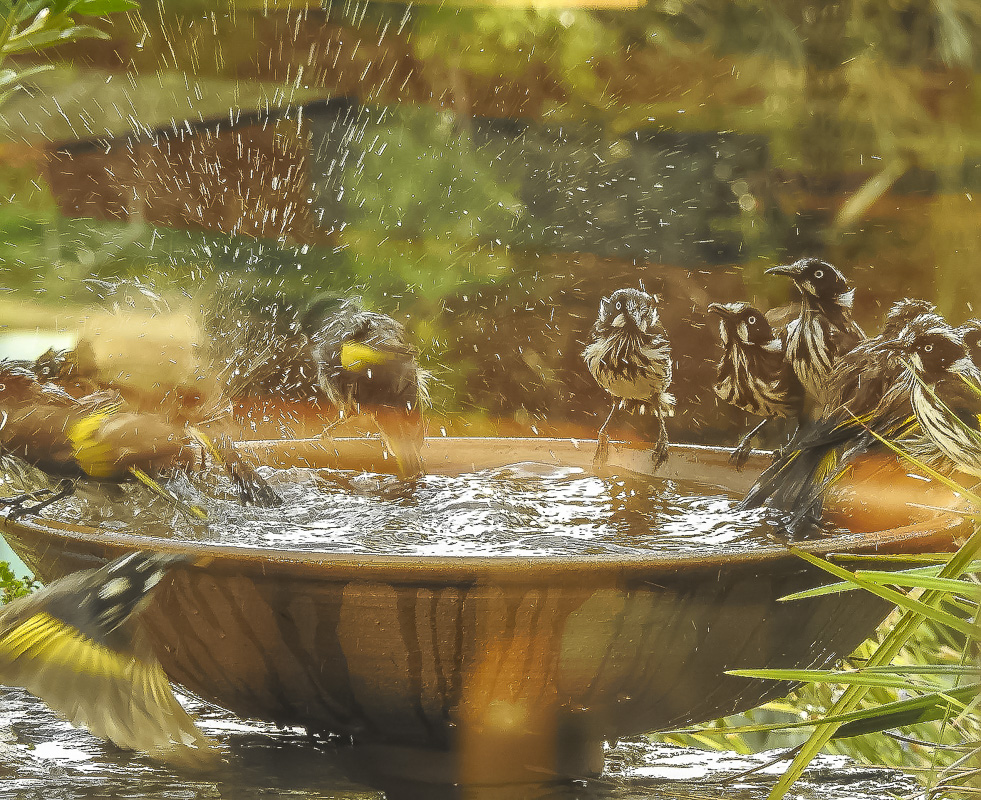
New Holland Honeyeaters at birdbath visible from dining room table
Twenty years has bound us to the site
Twenty years of gardening here have bound us to this garden in ways I could not have imagined when we began. We have worked with the site as planting has evolved, rather than strictly imposing original plans. This is truly a garden inspired by the site. Yes, we are at the mercy of the climate and the terrain, but within those constraints we have produced diversity and beauty that continues to surprise and delight. The garden also provides for a variety of native creatures. Even the carport is more of an aviary for swallows, the lawns a source of worms for magpies and green feed for Western Greys, the myriad ants a constant food supply for shy but distinctly present echidnas. Our main aim now is to continue here well into the future!
 Australian Native Plants Society (Australia)
Australian Native Plants Society (Australia)